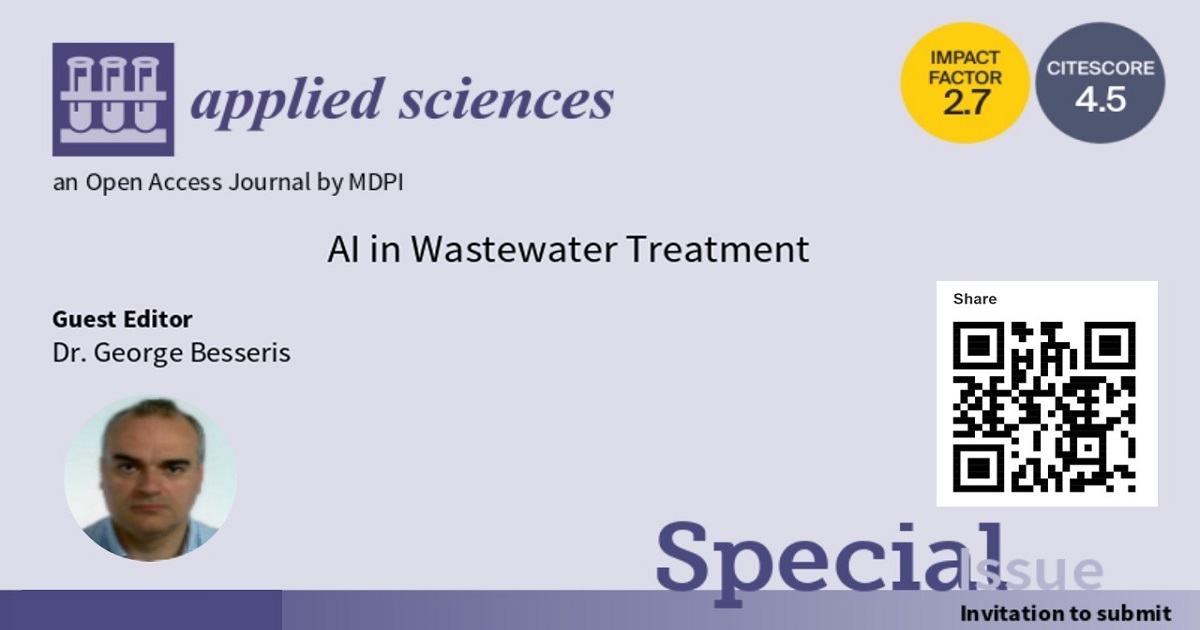AI in Wastewater Treatment
A special issue of Applied Sciences (ISSN 2076-3417). This special issue belongs to the section "Environmental Sciences".
Deadline for manuscript submissions: 20 May 2024 | Viewed by 979

Special Issue Editor
Interests: mechanical processes; optimization; chemical engineering
Special Issues, Collections and Topics in MDPI journals
Special Issue Information
Dear Colleagues,
Water is a vital resource for human survival and development. Sustainable water resources and water environment are a matter of human health and economic prosperity. Therefore, optimizing the recycling of water resources and ensuring water supply safety is essential for human development. Rapid advances in artificial intelligence technology are providing new ideas and methods to achieve this goal. The deep learning of collected data, analysis of sewage treatment patterns, and prediction and control of wastewater treatment quality can effectively improve the stability and accuracy of the wastewater treatment process. As a result, this technology can provide intelligent support for the wastewater treatment and control process.
This Special Issue aims to address the topics of applying Nature-inspired and machine learning techniques such as swarm intelligence, genetic algorithms and random forests to wastewater recycling quality by examining the effects of various influences on relevant water quality indices in applications that range from crop production improvement to effective environmental predictions in pollution control. Works on recurrent neural networks, wavelet neural networks, Elman neural networks, deep neural networks, support vector machines, fuzzy logic and adaptive neuro fuzzy inference systems, classification/clustering-based algorithms and other supervised, semi-supervised and unsupervised learning algorithms are also welcomed. Control studies using quantum walker approaches and dynamic non-linear autoregressive networks in predicting effluent quality variability are particularly desired. Case studies may also feature the prediction of optimal long-term wastewater treatment operations, the quantification of the effects of effluent trace metals on COD, dissolved oxygen optimization, the control of salt accumulation, the enhancement of filtration performance, the minimization of conductivity and membrane fouling as well as the maximization of flux in osmotic bioreactors. Other processes such as membrane distillation, electrodialysis, and micro-, ultra-, and nanofiltration-based operations may be also illustrated, among other relevant topics.
Dr. George Besseris
Guest Editor
Manuscript Submission Information
Manuscripts should be submitted online at www.mdpi.com by registering and logging in to this website. Once you are registered, click here to go to the submission form. Manuscripts can be submitted until the deadline. All submissions that pass pre-check are peer-reviewed. Accepted papers will be published continuously in the journal (as soon as accepted) and will be listed together on the special issue website. Research articles, review articles as well as short communications are invited. For planned papers, a title and short abstract (about 100 words) can be sent to the Editorial Office for announcement on this website.
Submitted manuscripts should not have been published previously, nor be under consideration for publication elsewhere (except conference proceedings papers). All manuscripts are thoroughly refereed through a single-blind peer-review process. A guide for authors and other relevant information for submission of manuscripts is available on the Instructions for Authors page. Applied Sciences is an international peer-reviewed open access semimonthly journal published by MDPI.
Please visit the Instructions for Authors page before submitting a manuscript. The Article Processing Charge (APC) for publication in this open access journal is 2400 CHF (Swiss Francs). Submitted papers should be well formatted and use good English. Authors may use MDPI's English editing service prior to publication or during author revisions.





